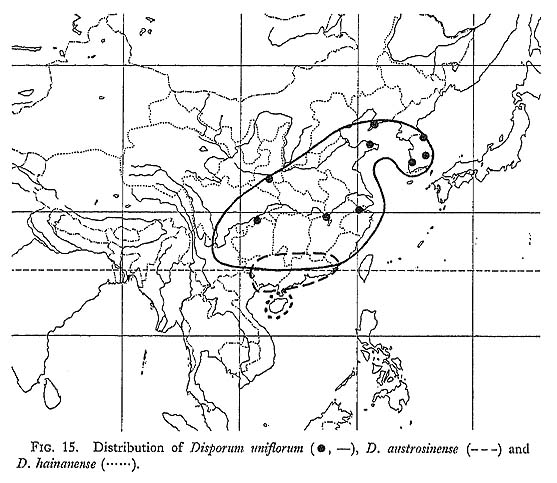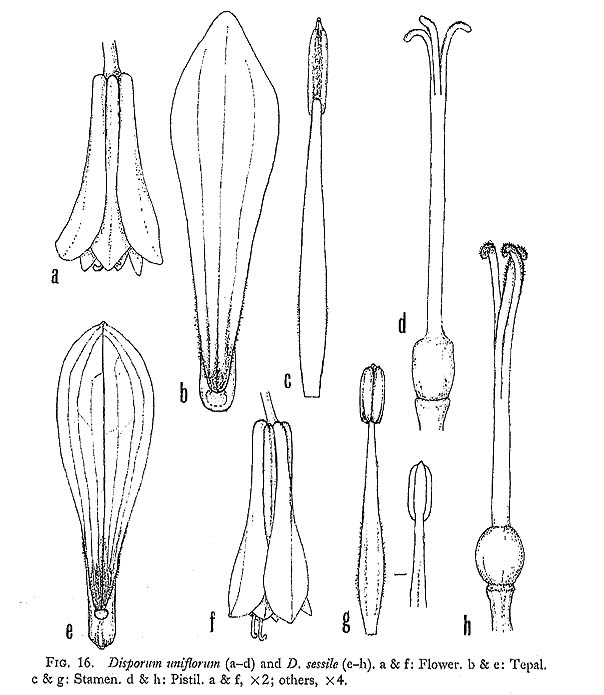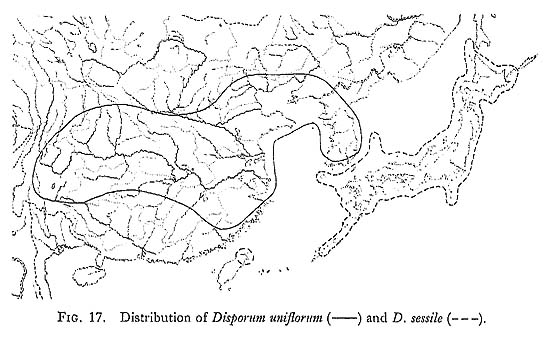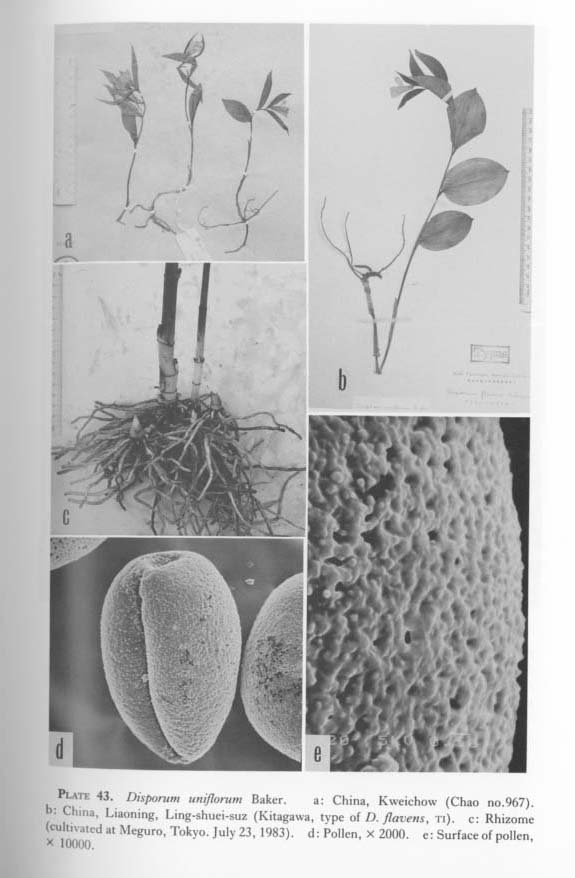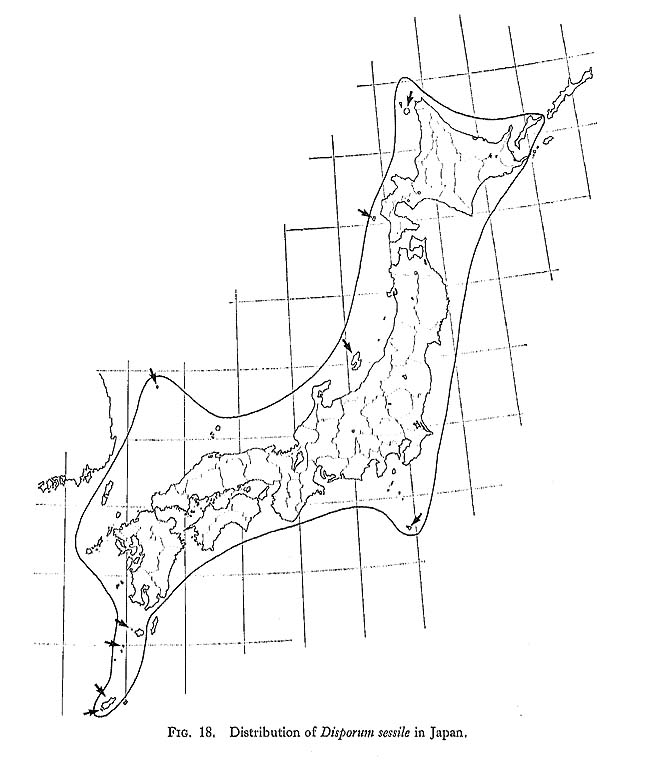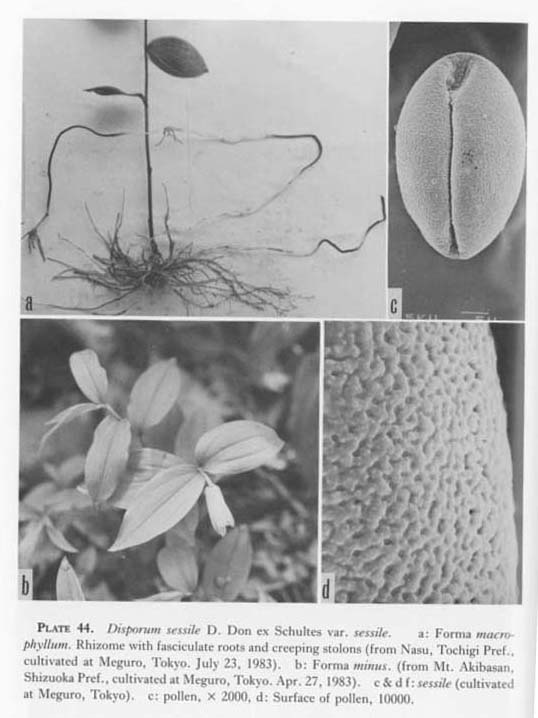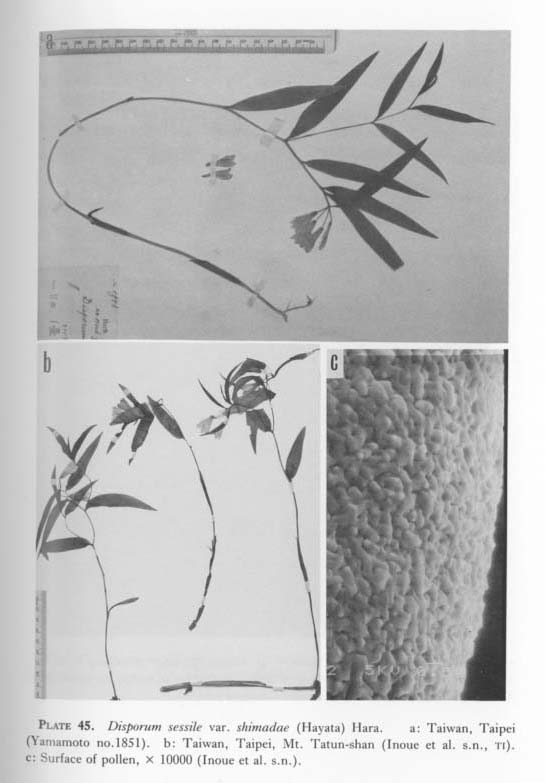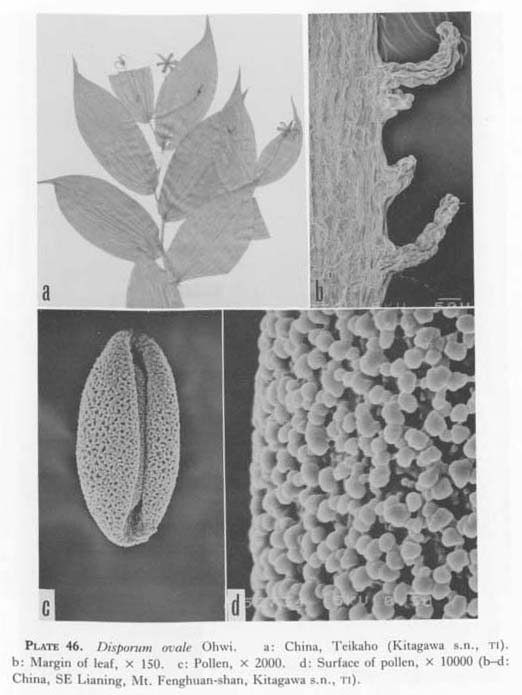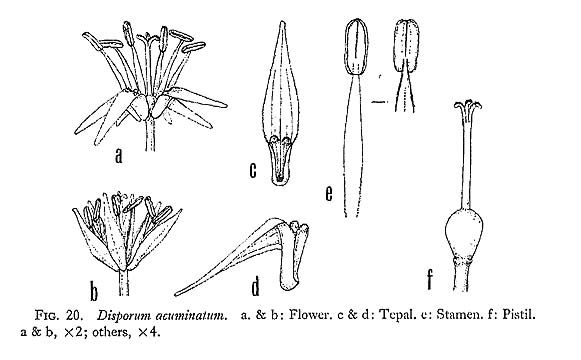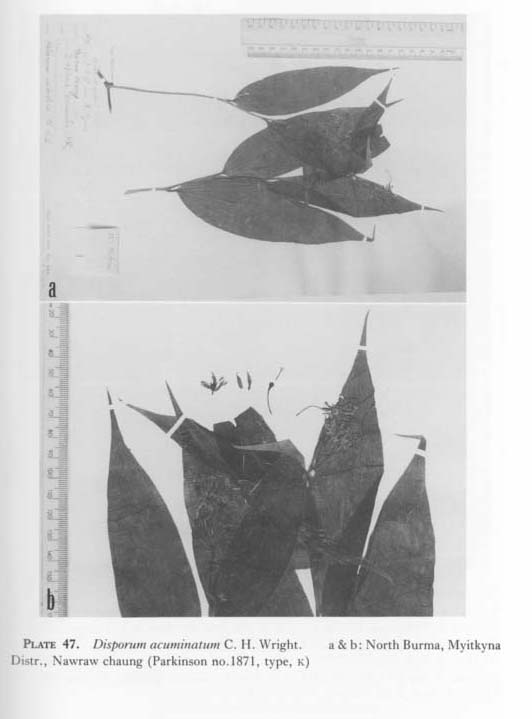A REVISION OF THE ASIATIC SPECIES OF THE GENUS DISPORUM (LILIACEAE)
Hiroshi HARA †
| ( 3 / 3 ) |
|
15) Disporum uniflorum Baker in S. Moore in Journ. Bot. 13: 230 (1875)-Mnxim. in Bull. Acad. Sci, St.-Pét. 29: 216 (1884)-C. H. Wright in Journ. Linn. Soc. 36: 144 (1903)-Hara in Journ. Jap. Bot. 58: 327, f. 3a, 4b (1983). [Colour plate 8c; Plate 43; Figs. 15, 16a-d, 17]
D. sessile D. Don sensu auct. plur. fl. chin.-Hance in Journ. Bot. 21: 358 (1883); 25: 13 (1887)-Franch. in Bull. Soc. Bot. Fr. 46; 214 (1899)-C. H. Wright, l.c. 143 (1903), p.p.- Matsuda in Bot, Mag, Tokyo 27: 82 (1913)-Hand.-Mazz., Symb. Sin. 7: 1207 (1936)-Wang et Tang, in Fl. Reip. Pop. Sin. 15: 45, t. 16.4 (1978), p.p. Rhizome shortly creeping, 4-7 mm thick, with short thick stolons 1-5 cm long, 3-6mm thick. Roots fasciculate, (1)2-4 mm thick. Stem. erect, 20-60(80) cm high, (3)4-10(12) mm thick, subteretc, ridged in the upper part, branched in the upper part or simple, often dark purple in the lower part, glabrous, with 2-3 vaginate bracts in the lower part. Leaves broad elliptic, broad ovate to oblong, 4-9 cm long, 1-6.5 cm wide, generally shortly acuminate or acute at the apex, roundish at the base, often broad-cuneate in the upper leaves, glabrous, with 5-7 main nerves; petioles short, 5-10 mm long. Inflorescences terminal, drooping, subanthesis often wrapped with the upper leaves, 1-3-flowered. Pedicels 3-5 mm long, almost smooth. Flowers cylindric-campanulate, (20)25-30 mm long, 12-15 mm in diameter, clear yellow, subtruncate and 4-7 mm in diameter at the base. Tepals spathulate-oblanceolate or obovate, 20-30 mm long, 5-10 mm wide in the upper part, gradually long-attenuate to the base, shortly (1-2 mm long) gibbose at the base, shortly acute or acutish at the apex, minutely papillose-hairy inside in the lower part and on lower margin, early caducous. Stamens slightly shorter than the tepal; filaments 17-20 mm long, yellow, very minutely papil lose in the lower part; anthers linear, 5-8 mm long, minutely apiculate, yellow. Ovary elliptic 4-5 mm long: style nearly as long as the tepal, 15-23 mm long including stigma 4-6 mm long, yellow. Berries subglobose or ellipsoid, 8-10 mm in diameter, blue-black. Fl. Mar.-May (Jun.). Fr. Jul.-Nov. Chromosomes 2n=16. In forests, alt. 100-2500 m; China and Korea. REPRESENTATIVE SPECIMENS. CHINA. Szechuan: Nanchuan Xien, Jinfo-shan, 1280 m (Xiong & Li no. 90481, Apr. 23, 1957, fl., sz); ibid. (Qu no. 1182, Jun, 6, 1935, fl., PE); Nanchuan, Baiwuping, 1040 m (Li no. 60490, Apr. 15, 1957, fl., PE; sz); Nanchuan, Fcnghuangsi, 2200m (? no. 3003, May 11, ?, fl., PE). Shensi: Taipai-shan, Heihukuan (K. T. Fu no. 2519, Apr. 27, 1939, fl., PE). Hupeh: Nanto (A. Henry no. 7635, fl.-typc of D. sessile var. pachyrrhizum Hand.-Mazz,, K); Hupeh & Szechuan (A. Henry no. 6731, fr., K; TI); Taihoo Lake (W. R. Charles no. 212, Apr. 1881, fl., K). Kiangsi: Kiukiang (Shearer, 1873, fl.-holotype of D. uniflorum Baker, k). Anhwei: Qingyang (K. K. Tsoong no. 3364, fl,, PE). Chekiang; Tsuyun-dong (K. Honda no. 1080 & 1081, Apr. 14, 1910, fl., TI); Hangchou (H. Migo, Oct. 20, 1934, fr., TI). Kiangsu: Chulinszu, Chinkiang (H. Migo, Sep. 23, 1934, TI); Ishang, 100-200 m (Teng no. 427, fl., PE). Shantung: Kunyu-shan, 100-700 m (? no. 0407, May 7, 1959, PE). Hopei; Y-hsien, 600 m (K. M. Kion no. 2102, May 23, 1934, PE). Liaoning: Ling-shuei-szu (M. Kitagawa, May 15, 1926, fl.-type of D. flavens Kitagawa, TI; May 2, 1926, fl., TI; Aug. 15, 1930, TI; Sep. 2, 1930, fr,, TI; Aug. 13, 1931, TI; May 22, 1932, fl,, TI). KOREA. Kogen: Kwang-nung (Y. N. Lee & Y. S. Lee no. 110, Apr. 25, 1967, fl., TI). Keihoku: Taikyu(T. Kobayashi, Jun. 1932, fl., TI). Zennan: m. Hakuyozan (T. Nakai no. 1283, May 3, 1913, fl., TI; no.10836, Jun. 4,1928,TI). Disporum uniflorum is distinguished from D. sessile not only by yellow flowers but also by the rhizome. In D. uniflorum, the stolons are short and thick, so the stocks grow in tuft. While D. sessile consistently bears long slender and horizontally creeping subterranean atolons sometimes up to 1 m long, so the plants grow loosely scattered. 16) Disporum sessile D. Don [Prodr. Fl. Nepal. 50 (1825), comb. non rite publ.] ex Schultes, Syst. Veg, 7 (1): 370 (1829)-Kunth, Enum. Pl. 4: 208 (1843)-A, Gray in Perry, Exped. 321 (1856); Bot. Jap. 414 (1859)-Miquel in Ann. Mus. Bot. Lugd.-Bat. 3: 147 (1867)-Baker in Journ. Linn. Soc. 14: 580 (1875)-Maxim. in Bull, Acad, Sci. St.-Pét. 29: 216 (1883)-Matsum., Ind. Pl. Jap. 2 (1); 194 (1905)-Mayabe et Kudo, Fl, Hokk. & Saghal. 3: 335 (1932)-Ohwi, Fl. Jap, 318 (1953); ed. Eng. 305 (1965); ed. rev. 373 (1965)-Kitamura et al,, Col. Ill. Herb. Pl. Jap. 3: 108 (1967)-Masamune, Col. 111.Fl. Nippon 8: 69, figs. (1969)-Satake et al., Wild Flow. Jap. 1: 48, t, 44.4 & 5 (1982). [Colour plate 8a, b; Plates 44, 45; Figs. 16e-h, 17, 18]
16a) Disporum sessile var. sessile. [Plate 44] Uvularia sessilis Thunb., Fl. Jap. 135 (1784), nom. illeg., excl. syn. U. sessilifolia L., quoad pl. jap. Nom. Jap. Hochaku-so. Rhizome creeping, with fasciculate roots 1-2.5 mm thick at the apex, later with long slender creeping stolons 10-50 cm long, sometimes up to 1m long. Stem 15-50(60) cm high, 2-6 mm thick, erect, green, subterete, with several sheathing bracts in the lower part, generally branched in the upper part. Leaves elliptic, oblong or narrow ovate, sometimes ovate or lanceolate, 4-11 cm long, 1-4 cm wide, acute, acuminate or long-acuminate at the apex, roundish or broad cuneate at the base, 5-7(9)-nerved, glabrous, very minutely scabrous on margin, pale green beneath, shortly petiolate. Inflorescence terminal or pseudo-terminal, 1-3 (4)-flowered, sessile, rarely pedunculate. Pedicels 10-25(35) mm long, slightly angulate. Flowers nodding, tubular-campanulate, 2-3 cm long, 8-12 mm in diameter, almost inodorous, whitish, generally green in the upper part and greenish white in the lower part, subtruncate and (4)5-6 mm in diameter at the base, Tepals spathulate or obovate, 5.5-12 mm wide, often roundish or obtuse and minutely apiculate at the apex, cuneate or long-attenuate to the base, strongly keeled on the back in the lower part, shortly (1.5-2(3) mm long) gibbose at the base, minutely papillose-pilose on margin and inside in the lower part. Stamens slightly or much shorter than tepals, (15)17-20 mm long; filaments (12)15-20 mm long, generally minutely papillose in the lower half; anthers linear-oblong, (3.5)4-6 mm long, yellow, slightly apiculate, basifixed, extrorse, not versatile. Ovary obovoid, 3-4 mm long, green; style slightly exserted or shorter than tepals, 12-23 mm long, white, smooth, trifid with branches 3-8 mm long. Ovules 3 per locule. Berries subglobose or broad ellipsoid, ±10 mm in diameter, blue-black. Seeds subglobose ±4 mm long. Fl. late Apr.-Jun. Fr. Aug.-Oct. Chromosomes 2n=16 (rarely 24). In forests on lowland and mountains, alt. 10-1450 m; S Sakhalin (Kaibato), S Kuriles (Kunashiri), Hokkaido, Honshu, Shikoku, Kyushu (south to Satsunan Is. including Yakushima, Tokara Is., Amami-oshima, and Tokunoshima), Quelpaert, and Dagelet. REPRESENTATIVE SPECIMENS. JAPONIA (Thunberg, Hcrb. no. 8182, fl.-type of D. sessile, UPS). SAKHALIN. Is. Todomoshiri, Tomarizawa (T. Miyake, Jul. 23, 1906, SAPT); Kotan, Is. Todomoshiri (T. Miyake, Jul. 24, 1906, SAPT). HOKKAIDO. Kitami: Rishiri, Oshidomari-Mt. Rishiridake, 200m (H. Kanai, Jul. 23, 1956, TI); Shonai, Esashi (H. Hara, Aug. 22, 1934, TI); *Oshinkoshin, Shiretoko (H. Hara et al., Sep. 9, 1974, TI). Teshio: *Mashike (H. Hara & 8. Kurosawa, Jun. 12, 1976, fl., TI). Ishikari: Maruyama, Sapporo (M. Mizushima, Jul. 16, 1945, fl., TI). Shiribeshi: *Mt. Taiheizan (H. Hara & S. Kurosawa, Sep. 3, 1977, TI). Hidaka: *Maruyama, Shoya (H. Hara et al., Sep. 11, 1974, fr., TI). Oshima: *Hakodate-yama (Y. Tomimoto, Jul. 24, 1931, TI). HONSHU. Aomori: *Aomori (G. Toba, May 22, 1932, fl., TI); *Mt. Orizume-dake (Tamaki, Jun. 14, 1911, young fr.,-holotype of D. sessile var. macrophyllum Koidzumi, TI). Iwate: Takizawa (G, Toba no. 22, Jun. 17, 1932, TI). Akita: *Tegata-yama. Akita (H. Muramatsu, May 20, 1928, fl., TI). Yamagata: Mt. Hagurosan (F. Maekawa & H. Hara no. 76, Jun. 12, 1937, TI). Fukushima: Kashi-onsen (H. Kanai, May 24, 1957, TI); *ibid. (C. Suzuki no. 7, Aug. 1, 1935-type of D. sessile var. doliciwcarpum Honda, TI); *Haguro-san, Soma-shi (H. Hara, May 18, 1958, fl., TI). Tochigi: *Karasuyama-joshi, Nasu (H. Hara, May 17, 1984, fl., TI). Gunma: *Mt. Tanigawa-dake (K. Hisauchi no. 74, Jul. 13, 1935, TI). Saitama: Mt. Buko (Y. Narita, Jun. 7, 1930, TI). Tokyo: Mejiro, Tokyo (H. Hara, May 17, 1929, fl., TI); Is. Mikura (N. Satomi no. 14457, Mar, 25, 1960, TI); Is. Miyake, Hamamae (N. Satomi, Mar. 15, 1960, TI); Is. Hachijo (S. Kitamura, Apr. 25, 1930, fl., KYO). Kanagawa: Yokohama (M. Togashi no. 216, Apr. 25, 1942, fl., TI). Chiba: Matsudoshi (N. Satomi, May 6, 1948, fl., TI). Niigata: Kirita, Saka-machi (M. Togashi & T. Yamazaki no. 6590, May 10, 1962, fl., TI); *Zao-yama, Kurokawa-mura (M. Togashi no. 9694, May 29, 1965, fl., TI). Nagano: Hirao-mura (S. Momose, May 27, 1929, fl., TI). Yamanashi: Oishichaya, Mt. Fuji (S. Adachi, Jun. 10, 1934, fl., TI). Toyama: Koshimichi-toge, Asahi-Machi (H. Kanai, Jul. 30, 1958, TI); *Sasatsu-yama (A. Hashimoto, May 19, 1935, TI). Ishikawa: *Kisomachi, Kanazawa-shi, (N. Satomi no. 5875, May 4, 1954, fl., TI). Fukui: Itofu-mura (M. Maeda, Nov. 1, 1951, TI). Shiga; Otsu (C. Hashimoto no. 9114, May 6, 1942, fl., TI). Mie: Ise, Gegu (H. Hara & S. Kurosawa, May 2, 1976, TI). Wakayama: Yawata, Arita (S. Okamoto, Jul. 17, 1933, fr., TI); *Higashimuro-gun (Y. Kitajima, Aug. 1927, fr., TI). Kyoto: Kurodani, Kyoto (M. Togashi no. 1558, Apr. 29, 1933, fl., TI). Hyogo: *Naigu, Oe-machi, 200m (T. Yamazaki & H. Kanai, May 12, 1968, fl., TI); Kuchiyokawa-cho, Miki-shi (G. Murata & M. Nishimura no, 700, Apr. 27, 1969, fl., TI). Okayama: Chiya-mura, Atetsu-gun (N. Satomi, May 17, 1952, fl., TI); *Onobe, NobaBe-mura (H. Kosaka, Jun. 1, 1930, fl., KYO). Hiroshima: *Taishakukyo (T. Tuyama, Aug. 1, 1932, fr., TI). Shimane: Anzoji-san, Nanokaichi-shi (H. Kanai, Oct. 12, 1958, TI). Yamaguchi: Yamaguchi-Tenjinyama, Yoshiki-gun (J. Nikai no. 100, May 8,1892, fl., TI); Mt. Kotsusan (K. Abe no. 45, May 16,1937, TI). SHIKOKU. Tokushima: Otaki-san, Waki-machi, 900 m (M. Takahashi no. 1074, Jul, 13, 1982, TI). Nan- kawa-mura (Watanabe ?, Apr. 17, 1890, fl., TI). Ehime: Mt. Ishizuchi (K. Kondo, May 20, 1928, TI), KYUSHU. Fukuoka: Himeharu-mura, Ukiba-gun (Y. Nabeshima, May 22, 1927, TI); Kokura. Mt. Adachi (T. Hashimoto, May 13,1952, TI), Oita: *Mt. Hikosan (T. Yamazaki, May 11, 1950, TI). Saga: Tosen-zan, Fujitsu-gun (T. Baba no. 41, Jun. 9, 1940, TI); *Kabeshima, Higashimatsuura-gun (J. Ouchi no. 7150, Aug. 20, 1955, TI). Nagasaki: Mt. Kinugasa (K. Kondo, May 17, 1927, fl., TI). Miyazaki: Higashi-kirishima, Miike, 400m (M. Togashi, Apr. 27, 1970, fl., TI). Kagoshima: Is. Yakushima, Kosugidani (G. Masamune, Jul. 30, 1924, TI). AMAMI-OSHIMA (Z, Tashiro, early Mar. 1924, fl., TI, KYO); Fukumoto, Uken (S. Tanaka, Aug. 11, 1891, TI); Fukumoto, Yamato-mura (S. Sako no. 5331, Mar. 23, 1965, fl., KYO); Yuwan-Mt. Yuwandake, Uken-mura (N. Fukuoka no. 7965, Apr. 7, 1970, fl., KYO); Mt. Yuwan-dake (G. Koidzumi, May 5, 1923, fl., KYO); ibid. (S. Iwamasa, Apr. 1, 1937, fl., Ti); near summit of Mt. Yuwan-dake, 650m (S. Hatusima & S. Sako, Mar. 24, 1958, fl., TI); Yamato-Sumiyo (G. Koidzumi, Apr. 30, 1923, KYO); Okumata, Naze City (S. Hatusima & S. Sako no. 21863, Mar. 26, 1958, fl., KYO). TOKARA Is.: Is. Akuseki, 300m (S. Sako no. 6245, Mar. 25-30, 1966, fl., TI). DAGELET Is. *Raridooho (T. Nakai no. 4153, May 31, 1917, fl., TI); *Joho, 600m (T. Ishidoya no. 14, May 26, 1914, fl., TI); *Kiri-yama (T. Nakai no. 4154, Jun. 8, 1917, fl., TI). QUELPAERT (J. Ohwi no. 9331, Mar. 1935, fl., KYO); in sylvis Hallaisan, 1200 m (U. Faurie no. 2119, May 1907, fl.-isotype of Tovaria Hallaisanensis Lév., TI; KYO); ibid., 800m (T. Taquet no. 4052, 1910, fl., TI); ibid. (T. Nakai, May 10, 1913, fl., TI); in sylvibus Hongno cascade (T. Taquet no. 6063, Apr. 15, 1912, fl., TI). Disporum sessile var. sessile f. macrophyllum (Koidzumi) Hara, comb. et stat. nov. [Plate 44a] D. sessile var. latifolia Miquel, Cat. Mus. Bot. Lugd.-Bat. 107 (1870), nom. nud. Nom. Jap. O-hochakuso (Koidzumi 1916). The representative specimens of f. macrophyllum were cited under var. sessile with*. Disporum sessile var. sessile f. stenophyllum (Franch. et Sav.) Hayashi [in Bull. Govern, Forest Exp. Stat. no. 133, 96 (1961), comb. nud.] ex Hara, comb. nov. Nom. Jap. Hosoba-hochakuso. REPRESENTATIVE SPECIMENS. HONSHU. Tokyo: Kariyose (T. Yamazaki no. 799, May 1, 1950, fl., TI). Chiba: Mt. Kiyozumi (T. Nakai, May 18, 1931, fl., TI). Kanagawa: Yokosuka (L. Savatier no. 1247 bis-type of D. sessile var. stenophyllum Franch. et Sav., P); Sengokuhara, Hakone (M. Togashi, Jun. 13, 1937, TI); Yokohama (T. Nakai, May 1932, fl.-type of D. sessile var. stenophyllum f. cupreum Nakai, TI). Shizuoka: Mochikoshi, Idzu (F. Maekawa, Jun, 1936, TI); Utogeno-taki, Setonoya-mura (D. Shimidzu, Aug. 8, 1930, TI). KYUSHU. Saga: Mt. Tosen-zan, Fujitsu-gun (T. Baba no. 41, Jun. 9, 1940, TI). Disporum sessile var. sessile f. minus (Miquel) Hara, comb. nov. Nom. Jap. Hime-hochakuso (Honda 1936), Ko-hochakuso (Nakai 1942). REPRESENTATIVE SPECIMENS, HONSHU, Nagano: Mt. Kumabushi, Hiraoka-mura, Shimoina-gun (S. Hojo, Jun. 5, 1965, fl., TI). Shizuoka: Mt. Akibasan (H. Hara, May 21, 1979, fl., TI). Wakayama: Mts. Koyasan, Mt, Settizan, 960 m (H. Ohashi no. 68657, May 13, 1968, fl., TI). SHIKOKU. Tokushima: Kawamata, Jinryo-mura (T. Inobe no. 11, Jun. 9, 1935, fl.- type of D. sessile var. Inobeanum Honda, TI); Mt. Asahimaruyama (T. Inobe, May 23, 1936, fl., TI); Sawadani-mura, Naka-gun (T. Inobe no. 71, Aug. 9,1940, TI); Mt. Kotsusan (K. Abe no. 46, May 16, 1937, fl., TI). Ehime: Mt, Nishi-akaishi ridge (T. Tuyama, Jul. 26,1934, TI). KYUSHU, Fukuoka: Mt. Hikosan, 800 m (T, Yamazaki, May 13, 1959, fl., TI). Nagasaki: Mt. Unzen (K. Ito-type of D. sessile var. minus Miquel, L); Mt. Unzen (F. C. Greatrex, Jun. 1930, TI); Mt. Taradake (T. Yamazaki, May 5, 1946, fl., TI); Tsushima, 450 m (N. Fukuoka no. 7568, May 11,1966, fl., KYO). Kumamoto: Hitoyoshi (K. Mayebara no. 5247, May 8,1967, fl., Ti), Kagoshima: Yodogawagoya to Mt. Miyanoura, Is. Yakushima (T. Yahara et al. no. 6050, Jul. 20-22, 1982, TI). QUELPAERT: Mt. Hallaisan (R. Cho, May 8, 1938, TNS). Disporum sessile is widely distributed throughout Japan, and is especially variable in the height of stem, the size and shape of leaves, and the size of flowers. The species propagates by long creeping subterranean stolons often covering a wide area, and in that case a population looks very uniform. Several infraspecific taxa have been described, but it is difficult to draw clear demarcation lines between them. On the other hand, we can observe some geoclinal tendencies and cannot ignore variations which give a clue to differentiation within this species. The typical var. sessile f. sessile is a middle-sized plant generally with a branched stem, and narrow oblong to elliptic leaves. This form is scattered widely in Japan, and is common in the southern part of middle Honshu. The plants of Satsunan Is. often have smaller flowers 15-20 mm long, shorter smooth filaments, and smaller anthers 3-4 mm long, and were named as var. micranthum Hatusima. But some plants especially of f. minus from Shikoku and Kyushu have similar small flowers and smooth filaments. Also some individuals of the Satsunan Is. have longer filaments minutely papillose in the lower part, and longer anthers, so they are included in var. sessile. Forma macrophyllum (Koidzumi) Hara generally has a robust branched stem with larger elliptic to oval leaves 8-16 cm long and 4-9.5 cm wide. This form prevails in Hokkaido, and the Japan-Sea side of Honshu (Tohoku, Hokuriku and Sanin), and Dagelet Is., and also on Is. Kabe-shima of Saga Pref. of Kyushu. Whereas f. stenophyllum (Franch. et Sav.) Hayashi and f. minus (Miquel) Hara are found in south-western Japan, and not in northern Japan. Forma stenophyllum with narrow lanceolate leaves often less than 2-3 cm wide, is common in the Hakone-Fuji-Idzu district, and also occurs in the southern part of the Kanto district, Tokai district, Shikoku and Kyushu, but intermediate forms between f. sessile and f. stenophyllum are also found frequently in those districts. Forma minus is a dwarf form generally with a simple stem bearing 1-2 flowers, and almost smooth filaments. This form occurs on mountains of Tokai district, Kii Peninsula, Shikoku, and Kyushu. It is noteworthy that the shape of leaves and the size of flowers are variable in this form. The type of var. Inobeanum from Tokushima Pref. of Shikoku has broad lanceolate leaves and small flowers 13 mm long. But even in the same prefecture, some dwarf plants have broad ovate leaves and larger flowers, and some others have narrow lanceolate leaves referrable to f. stenophyllum. The plants from Is. Yakushima also belong to a dwarf form, and have lanceolate leaves. As mentioned above, these forms are often connected by intermediate forms, but when typical plants of these forms are transplanted to Tokyo, they retain their own characters. 16b) Disporum sessile var. Shimadai (Hayata) Hara, stat. nov. [Plate 45] D. Shimadai Hayata in Journ. Coll. Sci. Univ. Tokyo 30 (1): 367 (1911)-Chao et al. in Bot. Bull. Acad. Sin., n.s. 4: 82 (1963). Stem 15-40(50) cm high, often 2-3-branched in the upper part or simple. Leaves oblong to lanceolate, 4-8 cm long, 5-25 mm wide, acute at the apex, cuneate to roundish at the base, glabrous, subsessile or shortly petioled. Inflorescence terminal, 1-3- flowered. Pedicels 7-18 mm long, angulate, glabrous or slightly rough on ridges. Flowers turbinate, 15-23 mm long, white or yellowish white, slightly opening in the upper part, 12-15 mm in diameter at the top, 3-4 mm in diameter at the base. Tepals ovate-spathulate, 17-23 mm long, 4-6 mm wide, obtuse or mucronulate at the apex, long-attenuate to the base, very minutely papillose on lower margin and inside in the lower part, shortly (2 mm long) spurred at the base. Stamens shorter than tepals, 12-17mm long; filaments 10-15 mm long, glabrous or sparsely papillose; anthers 2.5- 3mm long. Style 11-17 mm long, trifid at the apex, branches 3-6 mm long. Ovary obovate-ellipsoid, 2.5-3 mm long. Berries 4-6 mm in diameter, black. Fl. Mar.-Apr. Chromosomes 2n=14, 16 (Chang & Hsu, 1974). North Taiwan (Taipei), alt. 700-2300 m. REPRESENTATIVE SPECIMENS. TAIWAN. Taipei: Kelung (B. Hayata, Mar. 10, 1916, fl., TI); Chihsin-shan (T. Kawakami & S. Sasaki, Mar. 1911, fl., TI); Mt. Tatun-shan (K. Inoue et al., Mar. 22, 1977, TI). Disporum sessile var. Shimadai f. intermedium. Hara, f. nov. Caulis 30-40 cm altus, superne pauci-ramosus. Folia lanceolata-lanceolati-ovata, 4-8 cm longa, 7-28 mm lata. Inflorescentiae terminales, umbellatae, 1-3-flores. Pedicelli 15-20 mm longi, angulati, sub-laeves. Flores campanulati, 15-22 mm longi, basi 3.5-6 mm in diametro. Tepala obovati-spathulata, 4-6 mm lata, apice saepe rotundata et apiculata, sub-laevia, ad basin longe attenuata. Filamenta saepe minute papillosa; antherae 2.5-3.5 mm longae. Stylus 10-15 mm longus, breviter trifidus. REPRESENTATIVE SPECIMENS. TAIWAN. Hualien: between Tosato and Totokun (M. Tagawa, Apr. 11, 1940, fl., KYO; TI). Kwarenko: between Tosato and Totokun (M. Tagawa no. 3700, Apr. 11, 1940, fl.-holotype in TI; isotype in KYO). Chiayi: Mt. Arisan (B. Hayata, Apr. 30, 1914, fl., TI); ibid. (S. Sasaki, May 1913, fl., TI); Kaosiung: Kizan, Rokki (S. Okamoto, May 14, 1939, fl., KYO); Mt. Arisan (S. Sasaki no. 1-2, May 1913, fl.,TI). Takao: Kizan, Rokki (S. Okamoto, May 14, 1939, fl., KYO). Disporum Shimadai Hayata of Taiwan has been generally treated as a separate species from D. sessile of Japan, and differs from typical var. sessile by narrower lanceolate leaves, slightly smaller (15-20 mm) yellowish white flowers which open obliquely in the upper part and are narrowed to the base, shorter (12-15 mm long) stamens, almost glabrous filaments, and smaller (2.5-3 mm long) anthers. It seems to have elongate creeping stolons as in D. sessile. However, D. sessile var. micranthum of northern Ryukyu shows somewhat intermediate characters between D. Shimadai and D. sessile var. sessile. A narrow-leaved form similar to D. Shimadai occurs also in Is. Amami-oshima. However, in Taiwan, a form with a stem branched in the upper part, often broader leaves, slightly larger flowers which are 5-6 mm in diameter, and filaments often minutely papillose in the lower part is found, and this form is here treated as f. intermedium. Disporum Seet. 3. Ovalia Hara, sect. nov. Rhiztoma gracile, longe repens. Folia basi semi-amplexicaulia, margine pilis crassis obtuais saepe glandulosis praedita, Inflorescentia terminalis, fasciculata, 1-3-norifera. Flores rotati. Tepala oblonga, apice caudata, basi hand saccata, lutescentia, in parte superiore purpureo-maculata, raro alba. Bacca rubra. Semina ovoidea, laevia. Type: Disporum ovale Ohwi. Includes a single species m Korea and North China. Although Disporum ovale resembles the genus Streptopus in some characters as mentioned on page 163, it always has terminal inflorescence, and also the characters of the seeds and stamens agree with those of other species of Disporum, it is reasonable to retain this species in the genus Disporum. But it is interesting that in Asia D. ovale is the only species of the genus with red berries. Pollen grain of D. ovale has an exine of supratectral structure, and is finely reticulate with copiously tuberculate muri on surface, but the shape and density of tubercles are variable. 17) Disporum ovale Ohwi in Bot. Mag. Tokyo 45: 385 (1931)-Kitagawa in Icon. Pl. As.-Or. 1 (2): 26, t. 12 (1936); Neo-Lineam. Fl. Mansh. 172 (1979)-Satake in Journ. Jap. Bot. 17: 504 (1941)-Y. N. Lee in Ill. Fl. & Faun. Kor. 18: 152, t. 8, f. 35 (1976)- N. Lee in Journ, Korea, Pl. Taxon. 9: 13 (1979), incl. var. albiflorum Y. Lee et N. Lee-T. B. Lee, Ill. Fl. Korea 217, f. 866 (1982). [Plate 46; Fig. 19]
Streptopus ovalis (Ohwi) Wang et Tang [in Icon. Cormoph. Sin. 5: 509 & 933 (1976), comb. nud.] in Fl. Reip. Pop. Sin. 15: 49, t. 17.1-3 (1978). Nom. Jap. Kongo-so. Rhizome slender, long-creeping, ca. 2 mm thick, whitish, rooting at the nodes. Stem 14-50 cm long, simple or 2-3-forked in the upper part, flexuose and ridged in the upper part, often papillose on the ridge, with 3-5 vaginate leaves in the lower part. Leaves ovate to ovate-lanceolate, (2)3-11 cm long, 1-4(6) cm wide, acuminate to long caudate acuminate at the apex, semi-amplexicaul to roundish sometimes oblique at the base, herbaceous, 5-7-main-nerved, pale beneath, glabrous but ciliolate on margin and on main nerves beneath with thick blunt often glandular hairs 0.2-0.4 mm long. Inflorescence terminal, fasciculate with 1-3 flowers. Pedicels filiform, 1-3 cm long, less than 1 mm thick, angulate, often with scattered thick papillae. Flowers widely opening, 1-1.5 cm in diameter. Tepals oblong or lanceolate, (6)8-10 mm long, 1.8-3.2 mm wide, long caudate-acuminate at the apex, generally 5(7)-nerved, yellowish and purple maculate especially in the upper half, hardly saccate at the base. Stamens much shorter than the tepal, 3-4 mm long; filaments 2-3 mm long, ca. 0.7mm wide at the base, attenuate to the apex, whitish, glabrous; anthers elliptic, 0.8-2 mm long, yellowish. Ovary subglobose, ca. 2 mm long, slightly 3-ridged, scabrous on ridges, sparsely guttate, 2-3 ovules in a locule; style 2-4 mm long, shortly 3-lobed at the apex. Berries depressed globose, 6-8 mm long, 8-12 mm in diameter, depressed in the centre, dark red in mature, smooth, lustrous, juicy. Seeds globose-ovoid or flattish on one side, not curved, 3-4 mm long, yellowish white, smooth. Fl. Apr.-Jun, Fr. Jul.-Sep. Chromosomes 2n=16 (Lee, 1967). In forests, alt. 700-1600 m; Korea and North China (S Liaoning). SPECIMENS EXAMINED. KOREA. Kannan: Osorei (N. Nomura, Jun. 9, 1935, fl., KYO). Heihoku: Mt. Myoko-san (G. Koidzumi, Aug. 4, 1935, KYO); Mt. Hakuheki-san (T. Ishidoya, May 25, 1912, fl., TI); Kangkai (R. G. Mills no. 337, May 18,1911, fl., TI; PE). Heinan: Yotaku (T. Nakai no. 12491, Jun. 15, 1928, TI). Kogen: in monte Diamants (U. Faurie no. 271, Jun. 1906, fl.-type of D. ovale Ohwi, KYO; TNS); Mt. Kongosan (J. Ohwi, Jun. 10, 1932, fl., KYO); ibid. (M. Honda & Shim nos. 177 & 187, Aug. 12, 1943, fr., TI); Uchi-kongo (T. Nakai no. 5221, Aug. 13, 1916 & no. 5222, Aug. 17, 1916, fr., TI), Keinan: Mt. Chiisan (T. Nakai no. 356, Jul. 2, 1913, TI; J. Ohwi no. 6756, Jun. 1935, fl., KYO; S. Okamoto no. 18783, Sep. 1934 &no. 18787, Sep. 5, 1934,fr., KYO; T. & F. Yamazaki no. 3242, Aug. 20,1982, TI). QUELPAERT. Ins. Quelpaert (J. Ohwi no. 9296, May 1935, fl., KYO) ; Mt. Halla (N. Lee, May 27,1978, fl., TI); ibid. (N. Lee, May 27, TI). CHINA. Mt. Fenghuang-shan, SE Lianing (M. Kitagawa, May 1, 1932, fl., TI); Chichiapu, Teikaho (M. Kitagawa, Jun. 8, 1932, fl., TI); Lianshanguan, Hoten Pref. (J. Sato no. 9209, May 28, 1924, fl., PE); Motian Ling ( ? no. 328, May 24, 1950, fl., PE). Dispomin ovale f. albiflorum (Y. Lee et N. Lee) Hara, comb. nov. D. ovale var. albiflorum Y. Lee et N, Lee ex N. Lee in Journ. Korea. Pl. Taxon, 9: 13 (1979). Flowers white. SPECIMEN EXAMINED. KOREA. Quelpaert: Mt. Halla (N. Lee, May 27, 1978, fl.-isotype of D. ovale var. albiflorum Y. Lee et N. Lee, TI). Disporum Sect. 4. Paradisporum Hara, sect. nov. Folia magna, apice caudato-acurninata, glabra. Inflorescentia terminalis, umbellata, 5-8-florifera. Flores subrotati, albi. Tepala 6, lanceolata, basi leviter saccata, supra basin protuberationes duas praedita. Type: Disporum acuminatum C. H. Wright. The species is imperfectly known only from the type specimen from North Burma. When the flower, fruit, and chromosome are studied based on fresh material, the species may prove to be an independent genus. 18) Disporum acuminatum C. H. Wright in Kew Bull. 1929: 317 (1929). [Plate 47; Fig. 20]
Rhizome unknown. Stem tall, branched, smooth. Leaves large, oblong-lanceolate, 13-22 cm long, 3-7 cm wide, papyraceous, caudate-acuminate at the apex, roundish cuneate at the base, glabrous, very minutely cellulate on the margin, with 3 primary veins and several secondary veins; petiole 3-10 mm long. Inflorescence terminal, umbellate, subsessile, 5-8-flowered. Pedicels 10-22 mm long, slender, longitudinally striate, smooth. Flowers white, widely opening, about 2 cm in diameter, Tepals lanceolate, 9-14 mm long, 2-2.5 mm wide, long-attenuate to the apex, slightly saccate at the base, minutely papillose on the margin and inside in the lower part, generally 3-veined, furnished with 2 depressed semiglobose protuberances, which arc very minutely papillose on the surface, at 2.5-3.5 mm above the base, and often reflexed from that point. Stamens 6; filaments 7-12 mm long, somewhat thickened and minutely papillose in the lower part, attenuate to the apex; anthers oblong, 3-3.5 mm long, versatile, laterally and longitudinally dehiscent. Ovary obovate-globose, 3 mm long. Style 7-9 mm long, shortly trifid at the apex; stigmatose branches 2-3 mm long. Fruit unknown. SPECIMEN EXAMINED. NORTH BURMA. Myitkyna dist.: Nawraw Chaung (C. E. Parkinson no. 1871, Dec. 7, 1927-holotype of Disporum acuminatum. C. H. Wright, K). This is an aberrant and unique species in the genus. I have examined only the type specimen at Kew, and the above description and Plate 47 and Fig. 20 were prepared from the type. It is strange that the original description sometimes did not agree with the type. For example, such phrases as 'Tepals ... 2.4 cm long', 'basal appendage 5 mm long', 'Filaments ... 2.2 cm long', and "anthers ... 6 mm long' in the original description do not fit with the above description prepared from the type specimen. The pollen grains are distinctly reticulate on the surface. More complete material is needed to fix the correct systematic position of the interesting plant. Excluded Species1) Disporum Esquirolii Léveillé in Bull. Soc. Bot. France 54: 370 (1907). Type. China. Kouy-Tcheou: route de Pay So, Pa-yang, dans un tournant humidc près de l'Usine métallurgique de Fou-Pa et de la source de Pa-Yan (J. Esquirol no. 485, Jun. 1905, 'corolle blanche', E). = Tricyrtis macropoda Miquel sensu Baker in Bot. Mag.: t. 6544 (1881). The type specimen of Disporum Esquirolii Lév. has leaves finely pubescent beneath, whitish flowers, and anthers 5 mm long, and it agrees well with T. Bakeri var. glabra Koidzumi. 2) Disporum luzoniense Merrill in Philip. Journ. Sci. 5: 338 (1910). =Disporum fusco-picta Hance, fide Jessop in Fl. Males. 9: 219 (1979), et Kumar et Brandham in Kew Bull. 35: 493 (1980). 3) Disporum Mairei Léveillé in Le Mond des Pl. 18: 54 (1917). Type: China. Yunnan: halliers de Lan-ngi-tsin, 3300 m (E. E. Maire, Jul. ann. ?, 'fl. blanches', E.). =Stemona vcgula W. W. Smith in Not. Bot. Gard. Edinb. 10: 70 (1917), fide Evans or Stemona Mairei (Lév.) Krause in Notizbl. 10: 289 (1928), fide McKean. Selected Literature |
